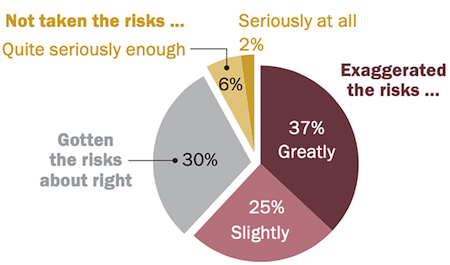Americans remain deeply divided on the facts surrounding the coronavirus (COVID-19) pandemic as well as their opinions regarding the media’s handling of it, according to a new survey released by the Pew Research Center.
Pew's report, which focused on Americans’ perceptions of COVID-19 as well as the ongoing media coverage and misinformation surrounding the crisis, found that about half of U.S. adults polled (48 percent) report that they’ve seen at least some made-up news about the pandemic, with about 12 percent of them claiming they’ve seen “a lot” of fake reports. About a third of Americans (32 percent) reported not seeing much fake COVID-19 news, and 20 percent said they hadn’t seen any. A quarter of Americans (26 percent) reported seeing conflicting facts about the outbreak.
This mix of conflicting information may have contributed to some of the ongoing confusion regarding the facts surrounding the outbreak. When asked about the virus’ origin, the survey showed that 43 percent correctly believe it most likely developed naturally, while nearly a quarter (23 percent) think COVID-19 was developed intentionally in a lab. Another six percent believe the virus was made accidentally in a lab, while one percent still think the entire crisis is made up. About a quarter of Americans said they still aren’t sure.
 Most U.S. adults think the media have exaggerated the risks surrounding the coronavirus (COVID-19) pandemic. Most U.S. adults think the media have exaggerated the risks surrounding the coronavirus (COVID-19) pandemic. |
Given the wealth of conflicting information, perhaps it should come as no surprise that Americans’ opinions regarding the threat of the pandemic remain divided. Nearly two-thirds of those polled (62 percent) said they think the media has exaggerated the risks associated with the outbreak, with 37 percent of them claiming the media have “greatly exaggerated” COVID-19’s risk. A quarter of Americans (25 percent) believe these risks are only slightly being exaggerated, while only 30 percent think the media have conveyed the coronavirus’ risks accurately.
The study confirms that the coronavirus’ dominance in the news cycle has caught Americans’ attention. About half of U.S. adults (51 percent) reported that they’re following coronavirus-related news very closely, with another 38 percent claiming that they’re following it fairly closely. A majority (70 percent) think the media have covered COVID-19 adequately, while a little less than a third (29 percent) believe the media’s coverage isn’t doing a good job.
Once again, however, partisanship arose as an evident variable in influencing Americans’ perceptions regarding the threat of the virus as well as the media’s treatment of it.
Among respondents who identify as Democrat or Democratic-leaning, 80 percent believe the media are doing at least somewhat of a good job covering the crisis, while only 59 percent of Republicans and Republican-leaning respondents are likely to believe this. About three-quarters, (76 percent) of Republicans believe the media have exaggerated the risks associated with the virus, a belief shared by only a fourth of that number (17 percent) among Democrats.
More than half of Democrats (52 percent) also more correctly identified that COVID-19 most likely came about naturally, while only little more than a third of Republicans (37 percent) believe this.
Pew’s analysis was based on a survey of more than 8,900 respondents drawn from the nonpartisan think tank’s American Trends Panel, a nationally representative list of randomly selected U.S. adults. Data for the report was compiled as part of the nonpartisan think tank’s Election News Pathways project, an ongoing initiative that seeks to understand how Americans are getting their news in the months leading up to the 2020 election. Surveys were conducted between March 10 and March 16.


 There’s a fine line between newsjacking and taking advantage, aka ambulance chasing. Our job as PR professionals is to tread it carefully.
There’s a fine line between newsjacking and taking advantage, aka ambulance chasing. Our job as PR professionals is to tread it carefully. PR firms need to be mindful of ways their work product may be protected by the attorney-client privilege whenever working with a client’s internal legal team or its external legal counsel.
PR firms need to be mindful of ways their work product may be protected by the attorney-client privilege whenever working with a client’s internal legal team or its external legal counsel. Manuel Rocha, former US ambassador and intenational business advisor to LLYC, plans to plead guilty to charges that he was a secret agent for Cuba.
Manuel Rocha, former US ambassador and intenational business advisor to LLYC, plans to plead guilty to charges that he was a secret agent for Cuba. CEO mentoring is an often-overlooked aspect of why CEOs are able to make good decisions, and sometimes make bad ones—all of which intersects with the role and duties of a board.
CEO mentoring is an often-overlooked aspect of why CEOs are able to make good decisions, and sometimes make bad ones—all of which intersects with the role and duties of a board.  How organizations can anticipate, prepare and respond to crises in an increasingly complex world where a convergent landscape of global challenges, threats and risks seem to arrive at an unrelenting pace.
How organizations can anticipate, prepare and respond to crises in an increasingly complex world where a convergent landscape of global challenges, threats and risks seem to arrive at an unrelenting pace.


 Have a comment? Send it to
Have a comment? Send it to 
No comments have been submitted for this story yet.